|
Keyboard
This is about the Model "M" keyboard. The heavy, clicky monster I love.
Keyboard Key (Capacitive switch, get some!)
Keyboard Connector Pinout
Keyboard and SDL Pinouts
M$ Elite Keyboard (Don't use it!)
Keyboard Emulator
Cleaning the Keyboard (How to Open
the KB)
Socket Sizes Needed
Keyboard Error Codes
Speaker Grill
Sources for SDL to PS/2 Cables
Present Model M Manufacturer
Location of Keyboard Connector
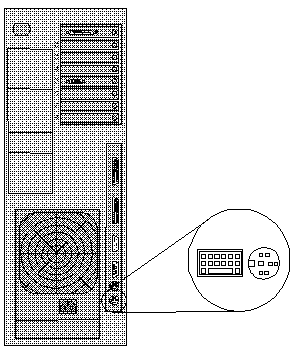
Keyboard Connector Placement
From Peter
On PS/2s, the keyboard port is the
one closest to the power supply.
Keyboard Key
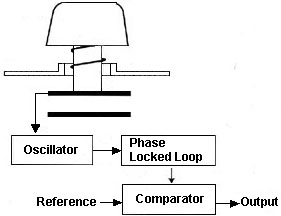
Capacitive Switches
A capacitive switch works when two plates (usually made
of plastic) are connected in a switch matrix designed to detect changes
in the capacitance of the circuit.
When the key is pressed, the plunger moves the top plate
relative to the fixed bottom plate. Usually a mechanism provides for a
distinct over-center tactile feedback with a resounding “click.” As the
top plate moves, the capacitance between the two plates changes and is
detected by the comparator circuitry in the keyboard.
This type of switch is nearly immune to corrosion and
dirt. These switches are very resistant to key bounce problems that result
in multiple characters appearing from a single strike. They are also the
most durable in the industry—rated for 25 million or more keystrokes, as
opposed to 10 to 20 million for other designs. The tactile feedback is
unsurpassed because a relatively loud click and strong over-center feel
normally are provided. The only drawback to this design is the cost.
Capacitive switch keyboards are among the most expensive
designs, but the quality of the feel and their durability are worth it.
From Tony
I've encountered 3 different quality levels of the IBM 101's so far.
1) Removable cable, heavy, clicky feel (the best)
2) Fixed cable, but otherwise same weight and click feel (OK) <--
Lexmark produced
3) Fixed cable, non-click squishy feel (horrible) <-- Lexmark produced
All of the Win95 style 104's I've seen sucked.
Keyboard Connector
Pinout
The keyboard and auxiliary-device connectors are 6-pin miniature DIN
connectors. The signals and voltages are the same for both connectors.
The following figure shows the pin numbering and signal assignments
for the auxiliary-device connectors.
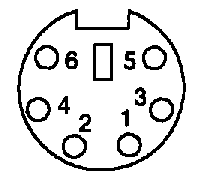
|
Pin
|
Signal
|
|
1
|
Data
|
|
2
|
Reserved
|
|
3
|
Ground
|
|
4
|
+ 5 V dc
|
|
5
|
Clock
|
|
6
|
Reserved
|
Signal
Voltages
The keyboard and auxiliary device signals are driven by open-collector
drivers pulled to 5Vdc through a pull-up resistor.
|
Sink current Max
|
20mA
|
|
Hi-level output V Min
|
5.0 Vdc minus pull-up
|
|
Low-level Output v Max
|
0.5 Vdc
|
|
High-level input v Min
|
2.0 Vdc
|
|
Low-level input v Max
|
0.8 Vdc
|
Pinout for
Keyboard Connector and SDL
SDL = Shielded Data Link, a type of shielded connector created by AMP
and used by IBM and others for keyboard cables
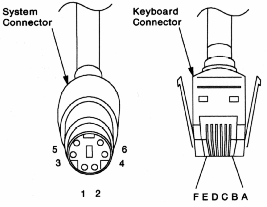
|
DIN
|
Signal
|
KB
|
+ DCv |
|
1
|
+KBD DATA
|
B
|
4.8-5.5 |
|
2
|
Reserved
|
F
|
|
|
3
|
Ground
|
C
|
|
|
4
|
+5.0 Vdc
|
E
|
2.0-5.5 |
|
5
|
+KBD CLK
|
D
|
2.0-5.5 |
|
6
|
Reserved
|
A
|
|
|
Shield
|
Frame Gnd
|
Shield
|
|
M$ Elite Keyboard
Hi John !
>I bought a micro soft elite keyboard pluged it into the keyboard port
, fired up the ole 9577 Launa and the screen lacks at the IBM screen.
From Peter
Uh ... that's normal. System self-protection you know
... :-) The Elite Keyboard has a different keyboard ID than "normal" keyboards
have - and it is intended for "ATX" machines AFAIK and behaves different
after a power on.
Most likely the 77 Lacuna keyboard controller gets a bit
confused by all of that - and hangs the system. Had that with several
Cherry "space saving" keyboards with integrated trackball as well.
Keyboard emulator
Try the Guardian
from www.raritan.com. Guardian for PS/2 -- APKME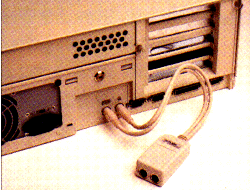
From Jim Shorney
> I was wondering if anyone could help me with finding an inexpensive
(i.e. >$20 or less) source for keyboard/mouse emulators.
Get a cheap keyboard, take the microcontroller circuit board out, whack
the cable to 6 inches or so, and reconnect the microcontroller board. Do
the same with a cheap mouse. Wrap in tape or put it in a small plastic
'project box' to insulate things.
Cleaning the Keyboard
> Can I safely open the keyboard or will all the springs, keys, etc.
jump out and land on the floor?
From Bob Eager
Remove the four hex head screws underneath (one needs
a long thin hex socket). Detach the cable too.
Turn the keyboard the right way up, and remove the top
half of the casing. All should be OK.
I use a pastry brush to clean it. You can remove most
of the keys (except for some of the 'long' ones which are best left alone).
Be very careful not to squash the spring when putting the key assembly
back. Best to tilt the keyboard, and let the spring 'fall' into the slot
in the key as it is pushed in (try it and all will be clear).And take the
keytop shells off to clean, of course
From Helmut P. Einfalt
And after you've done that, put all keycaps into an old
stocking (ask your better half if she has one with a ladder for you...),
knot it so as to keep the contents as loose as possible, and take that
bag as well both halves of the keyboard shell to the dishwasher.
Yeah. True. Wash it with a standard dishwasher program
-- you'll not recognize your keyboard afterwards anymore... (And yes, you
must take out the electronic innards before washing). If you don't believe
me, go ask Don Peter....
Did that on the original PS/2 mouse, too.... Works like
a charm.
From Peter
Do *not* remove the lower part of the keycaps - only the
upper part with the "lettering". The keycaps are a two-part assembly: the
"pushrod" and the keycap itself. Remove all keycaps - be careful with the
spacebar and the "bigger ones".
Socket Sizes Needed
From Myself, god-Emperor of Microchannel
I used a 7/32 socket- dunno what the metric size is. A
Nutdriver or a deep socket. I used an Ace 1/4" Drive - 6 Pt.
7/32", 2021947. The important thing is something deep enogh to fut in the
well that most of the screws are in.
From Peter
I got a SKG (Made in Germany) No. 493, 5.5mm Chrome Vanadium.
From the "tool wall" of our local super-market for about 3US$. Looks like
a long screwdriver with a thin walled socket as tip. Works perfectly well
since 1987 ...)
Dr. Jim
Speaking of Snap-on, they do carry a nice long socket
that works for these. We bought one for our shop; not cheap, but
worth it. 5.5mm, IIRC.
Incompatible Keyboard
From Charles Lasitter
Part 84G2524 / FRU 84G2529, mfg date 09/28/99, vendor:
Unicomp; IBM has managed to do the unthinkable. It now makes PS/2
input devices that can't stand the sight of real PS/2 equipment.
Specifically, keyboards made by this vendor for IBM work
great in crAptivas, but don't like Model 77s, 95s, and so on. Generates
the "301" keyboard error right away in the Model 95 computers, and generates
nonsense keyboard output attached to a Model 77.
I had several TrackPoint keyboards with sticky / weak
left mouse button bars, and I submitted them for service. The failure
was really one of annoyance / hindrance, as opposed to just plain broken
keyboards.
Well, these keyboards were returned in their place, and
the manufacturer was a new one. I can't remember the first manufacturer,
but I'd advise you to try FIND OUT before you go buying or giving up any
currently working trackpoint keyboard of this type.
Keyboard Errors
|
Error
|
Code Description |
|
3xx
|
KB errors |
|
301
|
KB reset or stuck-key failure (XX 301 XX = scan code in hex) |
|
302
|
System unit keylock switch is locked |
|
302
|
User-indicated KB test error |
|
303
|
KB or system-board error KB controller failure |
|
304
|
KB or system-board error KB clock high |
|
305
|
KB +5v error PS/2 KB fuse (on motherboard) blown |
|
341
|
KB error |
|
342
|
KB cable error |
|
343
|
KB LED card or cable failure |
|
365
|
KB LED card or cable failure |
|
366
|
KB interface cable failure |
|
367
|
KB LED card or cable failure |
Speaker Grill on Keyboard
>Well I know this has nothing to do with cleaning but... what is that
hole on the bottom of PS/2 keyboard. It looks like a mounting place for
some kind of a speaker or what?!
The first series of the MF-keyboard called MF-1 which lacked
the 3 status LEDs had in fact a speaker. It was designed for the XT family
of IBM PCs and was intended to be used for "professional typists", which
prefered to have a "click" in addition to the mechanical "keyclick" itself.
There was a software available, which enables / disables the speaker click
... standard was "On" AFAIK. Worked with that thing for some time back
in 1987 ...
The MF-II design 101/102 keys *with* the 3 status LEDs
inherited the entire case - and the speaker "grille" was left as an artifact
and no longer used or needed. Guess it was cheaper for IBM keeping the
old molding forms - and produce two keyboards on the same machinery.
SDL to PS/2 Cables
If you have a desktop, the 5' cable might work for
you. But for myself, I prefer the 10' cable. If you have a 80/85/95, you
have to go to the floor and behind the system. If you have a desktop, you
usually have to run the cable behind the system. This way you can sit away
from the monitor.
One place that still carries them is Jameco
1334026
IBM PS/2 5' Coiled Keyboard Cable 2.95 (closeout)
1393120
IBM PS/2 10' Coiled Keyboard Cable 3.95
Model M Maker
Unicomp bought the buckling spring technology from Lexmark.
It looks as if they have stocks on hand but aren't manufacturing more Model
Ms.
42H1292
IBM 101 key buckling-spring KB. Reg $79 Sale $49.00
1393278
IBM "SpaceSaver" compact, heavy-duty 84 key KB Reg $79 Sale $69.
9595 Main
Page
|



